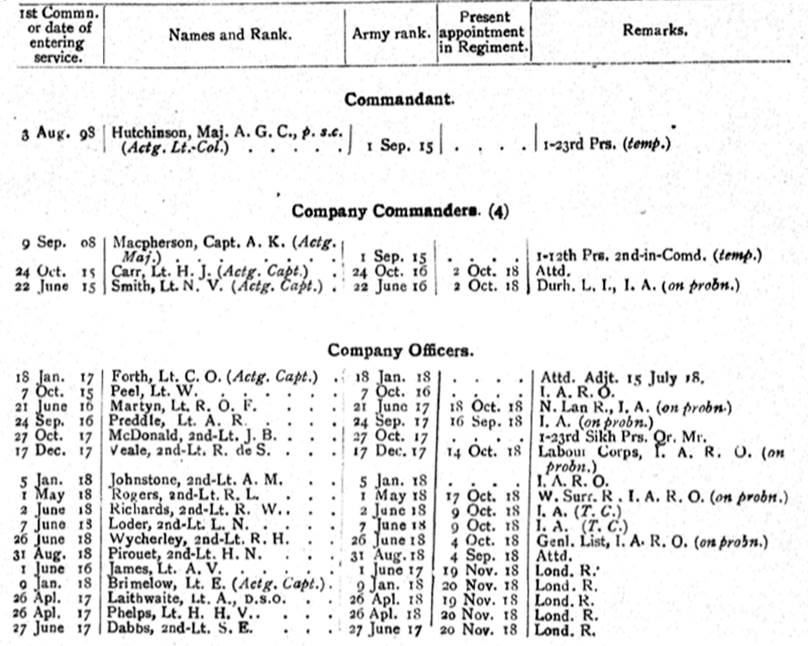This article is about the short-lived 3rd Battalion 34th Sikh Pioneers and will help you to research the Battalion and those who served with it during the First World War. I have created separate articles for the 1st and 2nd Battalions 34th Sikh Pioneers and a series of guides to help you research soldiers who served in the Indian Army during the war. To view the guides click on the blue links below:
- 1st Battalion 34th Sikh Pioneers
- 2nd Battalion 34th Sikh Pioneers
- Researching Soldiers who served in the Indian Army
The 3rd Battalion 34th Sikh Pioneers in the First World War
Lineage: Formed at Ambala on 13 June 1918 and disbanded on 1 July 1921. For a history of the Regiment’s lineage see my page on the 1st Battalion 34th Sikh Pioneers.
Class Composition of Battalion in 1919: 4 Companies of Mazbis and Ramdasia Sikhs.
The 3rd Battalion 34th Sikh Pioneers was a war-raised pioneer battalion formed at Ambala (Haryana, India) on 13 June 1918. The extract below was taken from the April 1919 Indian Army List and recorded the British officers serving with the Battalion. There were only two pre-war British officers serving the Battalion with most of the British officers only recently commissioned. This was typical of an Indian battalion raised late in the war.

War Diaries of the 3rd Battalion 34th Sikh Pioneers
There are two war diaries for the Battalion but neither have been digitized and can only be viewed at the National Archives. I have copies of both war diaries and have transcribed some of the entries below.
- Date: 01 June – 31 December 1919
- North West Frontier Force
- Reference: WO 95/5390
- Notes: A good war diary though many of the entries are short or consist of ditto marks. However, there are enough longer entries to give a good overview of the activities of the 3rd Battalion 34th Sikh Pioneers. There are no appendices.
- Date: 01 January – 31 October 1920
- North West Frontier Force
- Reference: WO 95/5398
- Notes: A good war diary which includes all casualties with their regimental number. However, some parts of the war diary are very hard to read. There is an appendix “Medical Arrangements” dated 28 February 1920 and a variety of different orders.
Further Sources for the 3rd Battalion 34th Sikh Pioneers
For information concerning British and Indian officers who served with the 3rd Battalion 34th Sikh Pioneers, the Indian Army List can be consulted.
Extracts from War Diaries of the 3rd Battalion 32nd Sikh Pioneers
29 June – 31 December 1919, North-West Frontier Force, WO 95/5390
25 July 1919 – Landi Kotal – Work on road. Wiring. A few shots were fired into camp from the East. These fell near out inlying picquet on the perimeter. There were no casualties. Pipe laying.
26 July 1919 – Landi Kotal – Work on road. Wiring. Shots were fired into the camp from the valley south of the Southern Perimeter ridge. Our inlying picquet on the perimeter saw a party of four or five enemy about 600 yards distance on the far side of the valley. Our picquet replied to the enemy fire. We sustained one casualty in the inlying picquet. No. 640 Sepoy Lena ? gunshot wound left hand.
17 September 1919 – Landi Kotal – After heavy rain night 16/17 September 1919 whole battalion sent on Landi Kotal – Ali Musjid road clearing road through nullahs, building up wash outs. Four companies spread over five miles motor and transport road. Work proceeded from 06.00 hours to 16.30 hours.
01 January – 31 October 1919, North-West Frontier Force, WO 95/5398
07 January 1920 – Kotkai – March out in direction of Ahnai and Whitechapel with Derajat Column. 2 Companies assisted in retirement. One Company suffered casualties during retirement. 2 Companies 109th Infantry retried through it followed by Mashuds estimated at 400. The Mashuds were checked [casualty list follows].
11 February 1920 – Piaza Raghza – Two Companies and Headquarters proceeded under cover of part Derajat Column and burnt and destroyed village.
19 February 1920 – Tanda China – One Company moved at 03.00 hours for construction of permanent picquet on Tree Hill in advance of camp and in proximity of Makin. Remainder of Battalion moved at 05.45 hours for destruction villages. Village Musa Khan destroyed and burnt. Part of two other villages destroyed and burnt. Four towers destroyed [casualty list follows].
22 February 1920 – Commenced further preparations for destruction and for burning 07.45 hours. Houses in village made ready for destruction. Trees prepared for demolition, water cuts and retaining walls, in Katch East and West of Marobi within a radius of 1000 yards destroyed.
12 March 1920 – Kanibu Ram – Rain during night 11/12 3.20, turning later to snow. 1/2 inch snow lying by daylight with snow still falling which turned again to rain at 12.00 hours. Whole battalion employed in draining water from camp and in clearing roads of water and mud.
18 July 1920 – Sunday, observed as a holiday. Heavy sniping from hills beyond Two Tree Hill Picquet from 22.15 hours to 23.30 hours. An enemy Lashkar had been reported. Picquets were doubled and the Regiment ”Stood To” under Brigade Orders. No casualties.
